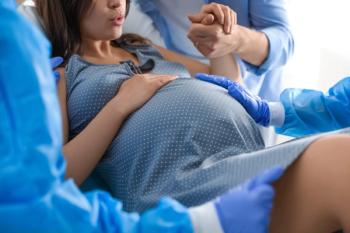
Walker-Warburg Syndrome
This is a case of a 19-year-old female referred to the high-risk obstetrical laboratory for evaluation because of an abnormal sonogram that indicated cerebral ventriculomegaly. A series of sonographic examinations were performed over a three-month period.
Case Study:
This is a case of a 19-year-old female referred to the high-risk obstetrical laboratory for evaluation because of an abnormal sonogram that indicated cerebral ventriculomegaly. A series of sonographic examinations were performed over a three-month period. The current case will focus on the images of the third examination; however, the age range analysis will use the results of four examinations for comparison. A Certified Genetics Counselor (BAK) met with the patient prior to and after the examination.
The current examination was performed at 31.1 weeks after the reported LMP by a registered sonographer (TJD) using modern equipment. The transducer used was a curvilinear with selectable 3.5 or 4.0 MHz frequencies. A complete examination was done, producing multiple planes of view of the major organs. The sonographic images were of a good quality and the examination was considered diagnostic.
The physician's (HBC) review of the images found hydrocephaly with an abnormal cranium. The cephalic measurements were considered relatively enlarged. Images of the posterior fossa demonstrated dysgenesis of the cerebellar vermis, suggesting a Dandy-Walker malformation. No other anomalies were seen on this examination. The amniotic fluid was normal.
The baby was delivered by C-section at the UAMS hospital due to hydrocephaly on September 15, 1997, a gestational age of approximately 36.6 weeks by LMP or 39.5 weeks by the 1st sonographic examination. The neonate was admitted to the Arkansas Children's Hospital. Postnatally, this baby was diagnosed with Walker-Warburg, a relatively rare autosomal recessive disorder. Clinical features present in this child included microphthalmia, lissencephaly, agenesis of the corpus callosum, vermian hypoplasia, and a possible Dandy-Walker variant. The family was counseled about the poor long-term prognosis and the recurrence risk of 25% in each pregnancy. Prenatal diagnosis is limited to ultrasound evaluation, as a specific gene defect has not yet been identified. Prenatal genetic testing may be available in the future on a research basis for these families.
Discussion:
Dandy-Walker malformations (DWM) are reported to have an incidence of one out of 25,000 to 35,000 cases, and are present in approximately four percent of cases with hydrocephalus.1 Others have reported that in pediatric cases hydrocephalus is associated with DWM in 13% of the cases.2 DWM covers a spectrum of abnormalities of the cerebellum that range from an increased indentation of the cerebellar vermis to complete agenesis of the vermis with a deep cleft between the hemispheres of the cerebellum. This cleft between the hemispheres represents enlargement of the 4th ventricle, is filled with spinal fluid, and is often referred to as a Dandy-Walker cyst. 3
This case provides a good example of a Dandy-Walker malformation with hydrocephalus. It also demonstrates the effects of hydrocephalus on fetal parameter size.
Above: Posterior fossa image, Dandy-Walker malformation of the cerebellum. A similar view of a normal cerebellum (not this case) is included for comparison.
Above: Transverse and coronal planes of the fetal head: hydrocephaly.
Above: Four chamber fetal heart and M-mode heart rate:
Above: Coronal view of the fetal abdomen: Normal bladder, stomach, liver and heart positions.
Above: Transverse view of the fetal abdomen demonstrating kidneys and femoral diaphysis measurement.
Fetal growth and age range analysis:
The following discussion is a presentation of the use of parameter age range analysis (
The use of the coronal view of the fetal head and the VCD allows a three dimensional evaluation of the fetal skull. The change in size of the 3D head and the use of the ARA to view the relative proportions of the parameters is particularly useful in cases of hydrocephaly or other head shapes and molding.. The following images help clarify these concepts.7
Above: Using a software package (
Above: By taking the ARA data and cutting out only the symbolic time-series distributions and lining them up week by week the growth and increasing distribution of the parameters size/ages can be easily observed. Note that the abdominal circumference (a) and the femur length (F) are approximately 2.7 weeks in advance of the LMP age (M) in examination #1, but by the 4th examination they are only about 1.6 weeks in advance of the LMP. This lag in body growth of one week may be indicative of some degree of IUGR. During the same period the head parameters moved from approximately 2.6 weeks (1st examination) to 3.9 weeks (4th exam) in advance of the LMP age. This acceleration in head size is attributed to the effects of hydrocephalus. It is also noted that the BB software program does not calculate parameter ages beyond 41 weeks, and in this case (Exam #4) the transverse head circumference (T) is beyond 41 weeks and is shown as "T+" arbitrarily at 42 weeks in the time-series.
Above: Another way of looking at this same data is to line up the LMP ages (vertical dotted line left of "M") and observe the relative positions of the fetal parameter's size/ages. The lagging in body growth and acceleration of the head size is again observed.
Acknowledgments:
The authors wish to acknowledge the contribution of the sonographers who performed these examinations:
Exam #1 Lisa C. Eddins, A.S., RDMS, RT(R)
Exam #2 Kristi Brewer, B.S., RDMS, RVT, RT(R)
Exam #3 Terry J. DuBose, M.S., RDMS, RT(R)
Exam #4 Mandi Graham, B.S., RDMS, RT(R)
Disclaimer: One of the authors (TJD) is the author and owner of the software
References:
References:
1. Sanders R C: STRUCTURAL FETAL ABNORMALITIES, The Total Picture. Mosby, 1966; p. 27.
2. Fleischer A C, Romero R, Manning F A, et al: ULTRASONOGRAPHY in OBSTETRICS and GYNECOLOGY, The Principles & Practice of; Appleton & Lange, 1991; p. 213.
3. Filly R A, Ultrasound Evaluation of the Fetal Neural Axis, in Callen P: ULTRASONOGRAPHY in OBSTETRICS and GYNECOLOGY, 3rd edition; W. B. Saunders Co, 1994; p. 192-195.
4. DuBose TJ, Poole E, Butschek C, et al: Range of Multiple Fetal Parameters. Official Proceedings 1988 World Federation for Ultrasound in Medicine and Biology; J Ultrasound Med, 1988; 7:S205-206.
5. DuBose TJ; "FETAL BIOMETRY: Vertical Calvarial Diameter and Calvarial Volume"; J Diagnostic Medical Sonography, 1985; 1:205-217.
6. DuBose TJ; Assessment of Fetal Age and Size: Techniques & Criteria: in Berman MC, Editor; Obstetrics & Gynecology: Diagnostic Medical Sonography, A Guide to Clinical Practice, Vol. 2; JB Lippincott ,1998.
7. DuBose TJ; FETAL SONOGRAPHY. W. B. Saunders Co., 1998; p. 95-199.
Newsletter
Get the latest clinical updates, case studies, and expert commentary in obstetric and gynecologic care. Sign up now to stay informed.




















